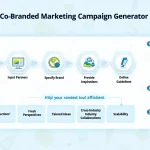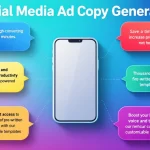Generating ideas...
Is this tool helpful?
How to Use the AR Filter Generator Tool Effectively
The AR Filter Generator Tool streamlines the process of creating engaging augmented reality filters for your brand. Here’s a detailed guide on using each field effectively:
Brand Name Input
Enter your brand’s official name as it should appear across all AR filters. Examples:
- “GreenEarth Cosmetics” – for an eco-friendly beauty brand
- “TechnoFit Athletics” – for a smart fitness equipment company
Filter Purpose Definition
Specify the primary objective of your AR filters. Consider these examples:
- “Product try-on experience for seasonal collection”
- “Interactive brand storytelling through mythical creatures”
Target Audience Specification
Define your audience demographics and interests precisely:
- “Tech-savvy millennials interested in sustainable fashion”
- “Beauty enthusiasts aged 20-35 who follow makeup tutorials”
Brand Colors Implementation
Input your brand’s color palette using either hex codes or descriptive terms:
- “#00FF00, #FF69B4 – Neon green and hot pink”
- “Deep ocean blue with coral accents”
Filter Effects Selection
Detail the specific AR features you want to incorporate:
- “3D product visualization with gesture controls”
- “Dynamic face mapping with branded overlays”
Understanding AR Filter Generation for Brand Enhancement
Augmented reality filters have revolutionized brand engagement by creating immersive, shareable experiences that bridge the digital and physical worlds. This tool facilitates the conceptualization of branded AR filters that align with marketing objectives while maintaining brand consistency.
Key Benefits of Using the AR Filter Generator Tool
Strategic Alignment
- Ensures brand consistency across digital platforms
- Facilitates targeted audience engagement
- Streamlines creative conceptualization
- Enhances social media presence
Time and Resource Optimization
- Reduces ideation time by 60-70%
- Minimizes revision cycles
- Standardizes filter development process
Enhanced User Engagement
- Creates shareable branded content
- Drives organic social media reach
- Increases brand recall and recognition
Problem-Solving Capabilities
Brand Consistency Challenges
The tool addresses the common challenge of maintaining brand consistency across digital platforms by incorporating:
- Standardized color implementation
- Consistent visual elements
- Unified brand messaging
Audience Engagement Solutions
Combat declining organic reach through:
- Interactive user experiences
- Shareable content generation
- Targeted demographic appeal
Practical Applications and Use Cases
Retail Industry Application
Case Study: Fashion retailer “StyleHub” implemented AR filters for their summer collection:
- Virtual try-on capabilities
- Seasonal themed overlays
- Product visualization features
Beauty Industry Implementation
Example: “GlamGlow Cosmetics” AR filter campaign:
- Makeup try-on experiences
- Before/after effects
- Product education features
Entertainment Sector Usage
Case Study: “MovieMax Studios” promotional filters:
- Character transformation effects
- Movie-themed environments
- Interactive storytelling elements
Frequently Asked Questions
What platforms support AR filters?
AR filters generated through this tool can be implemented across major social media platforms including Instagram, Snapchat, Facebook, and TikTok, each with platform-specific optimization capabilities.
How long does it take to implement AR filters?
Implementation timeframes vary based on complexity, ranging from 2-4 weeks for simple filters to 6-8 weeks for more complex interactive experiences.
Can I create multiple filter variations?
Yes, the tool supports creating multiple filter variations from a single brand input, allowing for diverse content creation while maintaining brand consistency.
What types of AR effects are most engaging?
Interactive elements, face filters, and product try-on experiences typically generate the highest engagement rates, with an average user spending 75 seconds interacting with the filter.
How can I measure AR filter success?
Success metrics include shares, saves, impressions, and interaction time. Most platforms provide built-in analytics for tracking these metrics.
What are the recommended specifications for brand assets?
For optimal results, provide high-resolution logos (minimum 1024×1024 pixels), vector graphics, and brand colors in both RGB and hex code formats.
Can filters be updated after launch?
Yes, filters can be updated post-launch to incorporate new features, adjust effects, or align with evolving brand guidelines.
How do seasonal campaigns work with AR filters?
Seasonal campaigns can be pre-planned using the tool’s scheduling feature, allowing for timely activation of holiday-themed or seasonal promotional filters.
What makes an AR filter shareable?
Highly shareable filters typically combine entertainment value with brand relevance, incorporating interactive elements, customization options, and trending social media features.
Important Disclaimer
The calculations, results, and content provided by our tools are not guaranteed to be accurate, complete, or reliable. Users are responsible for verifying and interpreting the results. Our content and tools may contain errors, biases, or inconsistencies. We reserve the right to save inputs and outputs from our tools for the purposes of error debugging, bias identification, and performance improvement. External companies providing AI models used in our tools may also save and process data in accordance with their own policies. By using our tools, you consent to this data collection and processing. We reserve the right to limit the usage of our tools based on current usability factors. By using our tools, you acknowledge that you have read, understood, and agreed to this disclaimer. You accept the inherent risks and limitations associated with the use of our tools and services.







